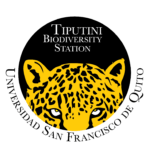
By being within the Yasuní Biosphere Reserve of eastern Ecuador, the Tiputini Biodiversity Station (TBS) is strategically positioned in the world’s most species diverse region – western lowland Amazonia at the intersection of the equator and the Andean foothills. TBS was established through a governmental stewardship agreement for ~7km2 on the left bank of the Tiputini River in 1994 as a collaborative effort between the Universidad San Francisco de Quito and Boston University. The station has three axes of action: investigation, education, and conservation. Our research has produced hundreds of scientific publications and results have been amply shared with tens of thousands of students from across the globe and the region.
Local Flora and Fauna
The hyper-diverse biotic richness of our neighborhood in Yasuní emphasizes a privileged biogeographical history and justifies status as a worldwide conservation priority. On average, over 600 species of trees occupy each hectare and, in all of Amazonian Ecuador, more than 2100 tree species occur. The Yasuní National Park has at least 550 fish species, 150 amphibian species, 120 reptile species, 550 avian species and 185 species of mammals – including dozens of iconic Amazonian vertebrates. Among the invertebrates, best estimates suggest that each hectare of intact forest houses 100,000 species of arthropods of which >80% are likely to be new to science. A 39-page January 2013 article in National Geographic faithfully depicts the overall story of the region – nature, indigenous culture, environmental threats, etc.
Infrastructure
Our facilities include a laboratory building of 600m2 (6000 ft2) fitted with wireless internet access, divided into two floors and distributed as classrooms, library, offices and research space. Housing is available for about 60 visitors and standard food service is provided. A network of well-marked trails that extend for about 40km (25mi) allows access for all visitors to all habitats. Several restricted trails and long-term research plots (two 1km2 areas separated by about 1km in upland forest, each with a 100m grid system and geo-referenced) are only available to investigators and their collaborators. Two observation towers (36 and 39m) and one system of suspended walkways (approximately 100m in length, at 25 to 30m height), all in terra firme, provide access to the uppermost parts of the canopy.
Camp Design and Layout
Generally speaking, our camp consists of a series of buildings dispersed over a space of about 2 hectares (4-5 acres) adjacent to the north bank of the Tiputini River; no building is more than 200m from the river’s edge, but all are situated on high ground that has no potential to flood. Each building is situated in its own clearing; we have made efforts to minimize the extent of deforestation necessary to accommodate our facilities, so the rainforest is literally just out the door from every structure. The laboratory (~600m2), our only two-story building, is situated in the middle of our camp about 100m from the river.
-

- Latin America
- Tiputini Biodiversity Station
- Yasuni Biosphere Reserve
- 220202
- Ecuador
- Orellana
- 0
- 76
- reservastbs@usfq.edu.ec
- https://www.tiputini.com/home
- 1994
- 2021
- Yes
- Universidad San Francisco de Quito USFQ
- Diego de Robles SN y Pampite
- Quito
- 170904
- Ecuador
- Pichincha
- Tomi Sugahara
- tsugahara@usfq.edu.ec
- Student Group Coordinator
- Gonzalo Rivas Torres
- grivast@usfq.edu.ec
- USFQ
- reservastbs@usfq.edu.ec
- tsugahara@usfq.edu.ec
- $50,001 - $200,000
- 501-1000
- Yes
- No
- Yes
- Yes
- Yes
- 21+
- 3-5
- 50+
- 51-100
- Yes
- Generator
- 61+
- Yes
- Yes
- Continuing Education/Informal learning
- Yes
- Yes
- Yes
- Terrestrial
- Tropical Rain Forest
- 101-300 meters
- 301-750 meters
- A (tropical)
- Yes
- Rural
- Yes
- Yes
- Yes
- Yes
- Yes
- Yes
- Yes
- 40
- 40
- 20
- Year Founded
- 1994
- Year Joined OBFS
- 2021
- Size of Field Station (hectares)
- 501-1000
- FSML Web Address
- https://www.tiputini.com/home
- Private nonprofit organization?
- Yes
- Universities affiliated / Parent Organization
- Universidad San Francisco de Quito USFQ
- Federal, state, or local governmental partners?
-
No
- Member of the Virtual Field
- No

